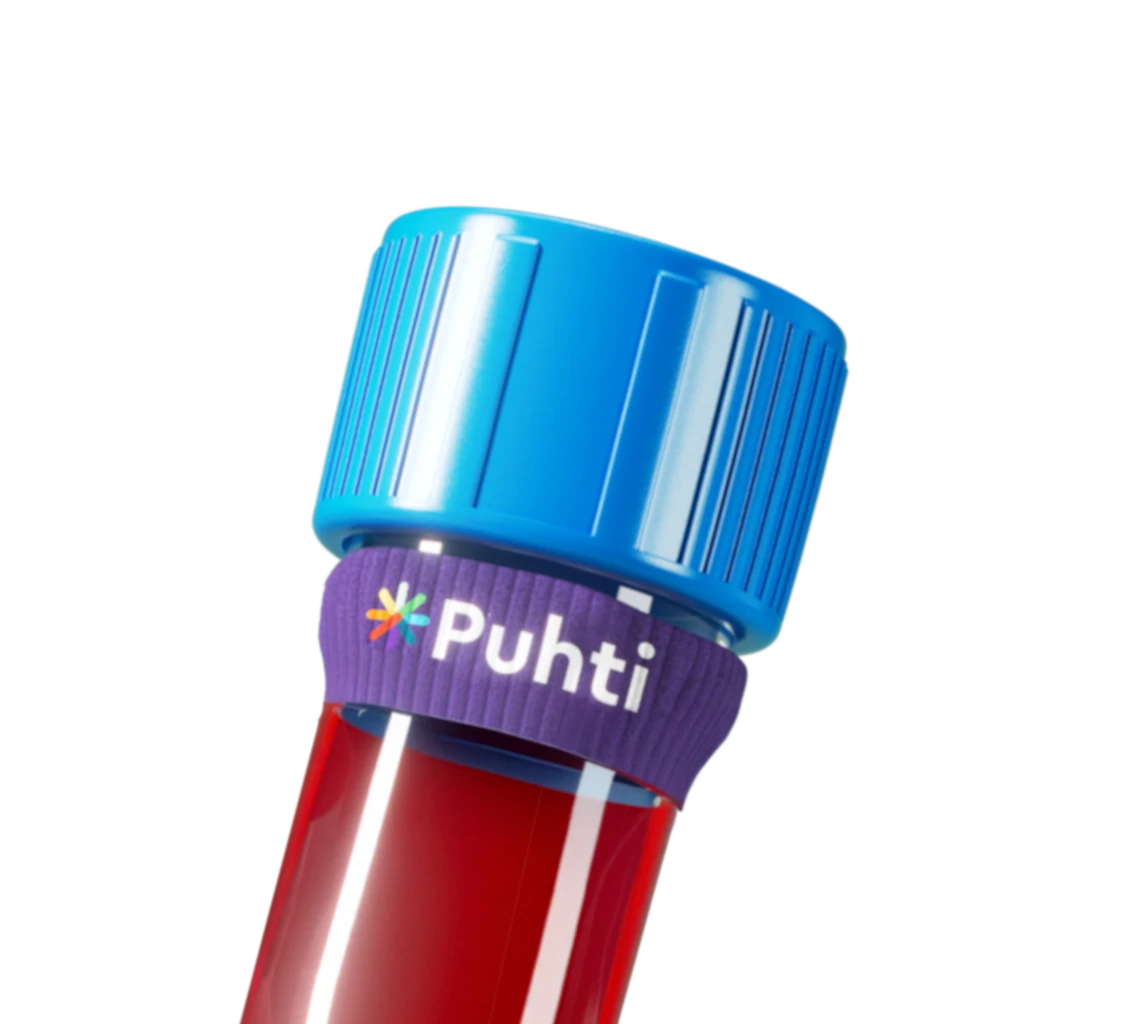
Ferritin, iron deficiency, and iron deficiency anemia: Symptoms, measurement, and treatment
Ferritin indicates the amount of iron stored in the body. Low ferritin level is a sign of low iron stores.

Ferritin, iron deficiency, and iron deficiency anemia: Symptoms, measurement, and treatment
Ferritin indicates the amount of iron stored in the body. Low ferritin level is a sign of low iron stores.
Ferritin and iron deficiency
- Ferritin indicates the amount of iron stored.
- Iron deficiency should be suspected if the ferritin value is under 30 µg/L.
- Most common symptoms of iron deficiency anemia are fatigue and impaired physical performance.
Ferritin
Ferritin is the primary test for iron deficiency. In addition to ferritin, iron levels and anemia can be determined through hemoglobin measurements; low hemoglobin indicates anemia.
Iron is recycled extensively in the body. The most important function of iron is to transport oxygen to the organs. Most of iron is used to form hemoglobin in red blood cells in order to transport oxygen from the lungs to the tissues.
80% of the body’s iron is functional (70% in hemoglobin, 10% in myoglobin and less than 1% in enzymes). The share of stored iron is 20% (in ferritin and hemosiderin).
Ferritin measurement (S-Ferrit)
Ferritin indicates the amount of iron stored. Low ferritin is a sign of low iron stores. Ferritin can be used to detect deminished iron stores before the development of iron deficiency anemia. Restoring low iron stores can prevent the development of iron deficiency anemia.
Ferritin is the primary test for iron deficiency.
You can check your ferritin levels via Puhti without a doctor’s referral.
Iron deficiency
Iron deficiency is the most common nutrient deficiency in the world. In simple terms, iron deficiency means that more iron is lost than is obtained from food.
Iron deficiency anemia
Iron deficiency is most common cause of anemia. Low hemoglobin reveals anemia. The most common symptoms of iron deficiency anemia are fatigue and impaired physical performance.
Roughly 25-40 % of women will experience iron-deficiency anemia at some point in their lives. Although this condition can affect anyone, it is rare in men and children.
Iron deficiency without anemia
If a person has a normal hemoglobin level but ferritin level is low, it is called as iron deficiency without anemia. That is a sign of low iron stores. The cause of low ferritin should always be investigated to ensure the right treatment.
In women, the most common cause of low iron stores is heavy menstruation. Iron can also be lost due to any other bleeding. Insufficient iron absorption (due to celiac disease or other intestinal diseases, for example) may also be the reason for low iron stores.
Symptoms of iron deficiency anemia
The symptoms of iron deficiency anemia are diverse. Symptoms can also be due to factors other than iron deficiency anemia. The symptoms are more pronounced the worse the anemia is. Iron deficiency anemia can cause, for example, the following symptoms:
- fatigue
- paleness
- decreased physical performance and general condition
- impaired general health
- palpitations
- shortness of breath
- dizziness
- weakness
- headache
- hair loss
- restless legs
- oral symptoms
Symptoms can also be related to some other condition or disease.
If you suspect an illness or have symptoms, we recommend contacting a healthcare professional.
High-risk groups for iron deficiency
There are several high-risk groups for iron deficiency. Iron deficiency often occurs, for example, in women of childbearing age, the elderly, athletes, and in connection with bleeding or blood donation. Iron deficiency occurs especially in the following groups:
- women with heavy menstrual bleeding (heavy bleeding on more than 2–3 bleeding days)
- people with a disorder related to the absorption of iron or other intestinal diseases, such as celiac disease
- people with inflammatory bowel disease
- people who have had heavy bleeding, for example, due to accidents, surgery, childbirth, or persistently bleeding hemorrhoids
- persons who have repeatedly donated blood
- the elderly (due to poor nutrition or illnesses)
- pregnant women (pregnancy increases the need for iron)
- athletes (intense sports increase the need for iron)
What are the functions of ferritin and how does it work?
Ferritin indicates the amount of iron stored. Ferritin also transports iron within the body.
- Ferritin stores the body’s iron. If there is too little of this storage protein in the body, iron levels are also low.
- Iron doesn’t circulate freely in the bloodstream but is found within ferritin and transferrin. This allows it to reach the places where it is needed. 10 % of the body’s iron travels within ferritin, and 90 % within transferrin.
- In cases of inflammation, ferritin levels can rise, thus so ferritin measurement is not recommended for assessing iron deficiency when a person is sick.
- A low ferritin level usually indicates iron deficiency.
Reference values for ferritin
Reference values used in Puhti tests are presented in the tables below. The notation µg/l means micrograms per liter.
Reference levels may vary depending on the laboratory and the test analysis method. Puhti samples are taken and analysed at the laboratories of Mehiläinen.
Reference values for ferritin in adults
In the table below, you can see the reference values for ferritin:
| Women | 15–125 µg/l |
| Men | 20–195 µg/l |
However, on the basis of recent research, a limit value of 30 µg/L for ferritin has been accepted as an indicator of iron deficiency. Iron deficiency should be suspected if the ferritin value is under 15–30 µg/L and the person shows typical iron deficiency symptoms and is in a high-risk group of iron deficiency (due to, for example, heavy menstruation, multiple births, long-term proton pump inhibitor therapy, regular blood donations).
Ferritin values above 100 µg/L generally exclude the possibility of iron deficiency anemia.
Reference values for ferritin in children
Please always consult a doctor to assess the need for conducting tests on small children. We recommend discussing the situation and the need for laboratory tests with a doctor. When starting an iron supplement for a child, it’s advisable to consult with a doctor.
Ferritin tests when planning pregnancy
When planning pregnancy, ferritin can be tested to ensure that the person’s iron stores are in order at the beginning of pregnancy. During pregnancy, the need for iron increases and blood is also lost during childbirth. These may lead to iron deficiency anemia.
How can I increase my ferritin levels?
The cause of low ferritin should always be investigated to ensure the right treatment. Making healthy choices and taking oral iron supplements are the primary methods for normalising ferritin levels. If iron deficiency is caused by heavy menstrual bleeding, treating the symptom of bleeding is a priority. Otherwise, the heavy loss of iron will continue and iron supplements will not be enough to replace the lost iron.
The greater the lack of iron, the more iron is absorbed.
According to research, the intake of oral iron supplements can be reduced to every other day. This can help, in particular, with any stomach issues.
Restoring the body’s iron stores is slow and iron supplements are recommended to be used for a long time. Oral iron supplements are recommended for at least several months or even 6–12 months. However, ask your doctor for your personal needs. Through the Puhti service, you can order a remote consultation with a doctor after the tests.
Haemoglobin levels may return to the reference values quite rapidly, over a period of weeks or months. Iron stores, on the other hand, may take up to six months to replenish.
Intravenous iron infusion is rarely needed but in certain cases it is necessary. However, healthy individuals are primarily advised to take oral iron supplements.
Anemia can be caused by factors other than iron deficiency
In anemia, the level of haemoglobin in the blood is lower than normal. It is important to diagnose the correct type of anemia to ensure the right treatment. The most common cause of anemia is iron deficiency, but vitamin B12 or folate deficiency may also cause anemia.
The most common symptoms of vitamin B12 deficiency are cognitive symptoms related to thinking and memory, muscle weakness, and sensory symptoms.
Deficiency of folic acid or folate (vitamin B9) can be avoided by following a varied diet and avoiding excessive alcohol consumption.
Vitamin B12 deficiency is mainly found in elderly people and vegans. One in ten Finns over the age of 65 is diagnosed with a vitamin B12 deficiency. In young people, vitamin B12 deficiency is less common. Those following a vegetarian diet, and especially vegans, should take a dietary supplement containing vitamin B12, as this vitamin is only obtained from products of animal origin.
Treatment for iron deficiency
The treatment of iron deficiency is based on what causes it. Treating heavy menstrual periods is the primary approach if it is the cause of iron deficiency. Iron deficiency can be effectively treated through both dietary adjustments and dietary supplements.
- Iron-rich foods can be added to the diet.
- Foods that enhance iron absorption can be included.
- Foods and drinks that hinder iron absorption can be avoided.
- If necessary, an oral iron supplement can be used.
- Intravenous iron supplements are rarely used for the treatment of iron deficiency.
How does diet affect iron deficiency?
The body’s iron levels can be influenced through diet. Iron must be obtained from the diet. Those suffering from iron deficiency should favor food that is rich in iron. If changing dietary habits is not possible or is difficult, takinkg an iron supplement is an option.
In the case of iron deficiency anemia, changing the diet alone is not sufficient, and iron supplements are necessary.
Vitamin C aids in the absorption of iron.
It is advisable to avoid drinking coffee, tea, and milk at the same time as iron-rich foods, as they interfere with the absorption of iron from food.
Calcium and magnesium supplements reduce iron absorption.
Alcohol and smoking also interfere with iron absorption.
Which foods are rich in iron?
The following foods, for example, are great sources of iron:
- Lentils
- Beans, such as navy beans, broad beans, black beans, kidney beans, and soybeans
- Soy preparations, such as soya flour
- Chickpeas
- Quinoa
- Rye bread
- Pumpkin, sesame, chia, flax, sunflower, poppy and hemp seeds, and pine nuts
- Tahini
- Variegated bolete
- Pulled oats
- Tuna
- Blood and liver foods (such as blood pancakes)
- Red meat
- Game
- Spinach, nettle and arugula
- Nuts (especially cashew nuts) and almonds
- Seed mixes and seed breads
- Pasta, potatoes and rice
- Peas and pea shoots
- Eggs
- Clams, crustaceans and fish
- Dried basil and oregano
- Plums
Remember to combine these foods with foods with vitamin C, and avoid foods and beverages that decrease iron absorption at the same meal.
Which foods decrease the absorption of iron?
- coffee
- tea
- dairy products (such as cheese, milk, yoghurt, quark)
- foods enriched with calcium (including plant-based foods such as soy and oat milk)
- alcohol
- calcium and magnesium supplements
Recommended iron intake
Dietary iron intake recommendations are shown in the table below.
| Age and gender | Amount / day |
| Adult woman | 15 mg |
| Adult man | 9 mg |
| Over 60 years old | 9 mg |
| Under 10 years old | 8-9 mg |
| Youths 10-17 years old | 11 mg |
On average, only 10 percent of the iron obtained from food is absorbed for use by the body.
A man’s iron stores are approximately 3.8 grams, while a woman’s are 2.3 grams.
High ferritin
Ferritin may also be elevated. High ferritin can produce a variety of symptoms that may resemble iron deficiency and low ferritin. Elevated iron is a rare condition. However, iron can accumulate in the body if it is absorbed more than normal in connection with an illness. Repeated blood transfusions as well as heavy and prolonged use of iron supplements can lead to an excessive accumulation of iron in the body.
What causes high ferritin? What raises ferritin levels?
Ferritin can also increase due to an inflammatory condition or a disease, in which case it may not reflect adequate iron stores. Examples of inflammatory conditions:
- inflammation
- liver damage
- rheumatoid arthritis
- other inflammatory diseases
High ferritin levels can also be caused by haemochromatosis, an inherited disorder that affects the absorption of iron.
Hemochromatosis
Hemochromatosis is a condition in which the body stores too much iron. The condition stems from a gene mutation that increases the absorption of iron through the intestines.
How can I get my ferritin tested?
You can order the ferritin as a single test from Puhti’s online store. Add the desired products to the shopping cart and complete all the tests at once.
The ferritin test is included in the following test packages:
- Puhti laboratory package
- Extensive Puhti laboratory package women
- Extensive Puhti laboratory package men
First, order the tests you need via Puhti. You do not need a doctor’s referral. You can visit one of our many laboratories in Finland. Most of the laboratories also serve customers without an appointment. You will receive an easy-to-read results report.




